In recent years, AMD has been in a position to react to Nvidia in the graphics card landscape. The RX Vega 64, which launched in August 2017, was an answer to the high-end GTX 1080 that first hit the market in May 2016. This time around, AMD's schedule isn't as far behind; the new Radeon VII is AMD's answer to Nvidia's RTX 2080 that came out in September 2018. And just like RX Vega, Radeon VII isn't here to blow Nvidia's lineup out of the water, rather, it's a viable option to compete with the newest generation of GeForce cards.
AMD isn't rolling out fancy new graphics technologies like Nvidia did with RTX's real-time ray tracing or AI-powered supersampling (aka DLSS) for gaming, as those technologies are specifically tuned for Nvidia's Turing GPU architecture. But what AMD does offer is a significant improvement over its previous generation with a more efficient version of the Vega architecture, a ton of video memory (VRAM), and improved video encoding for content creators. In this review, however, we'll be measuring performance in eight graphically demanding PC games to see how it stacks against other cards. At $700 USD, the Radeon VII shares the same suggested retail price as the RTX 2080. And as you'll see from our tests below, while AMD's new card stays competitive, its raw performance doesn't quite justify the price point.
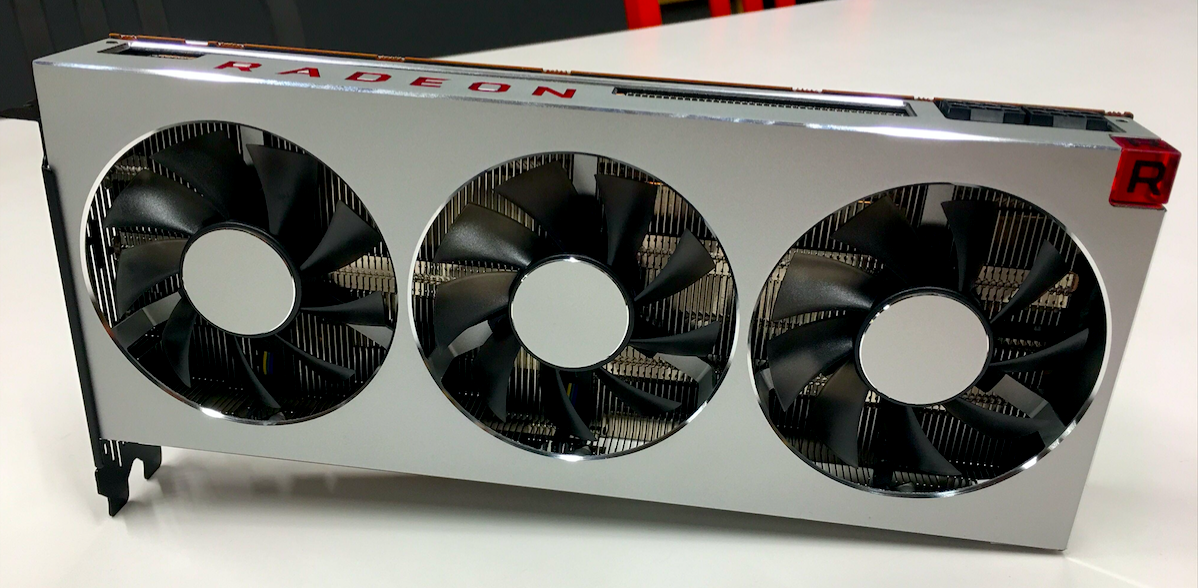
Technical Details
Radeon VII is the first consumer-level video card built with the 7nm manufacturing process, which allowed AMD to create the smallest GPU die yet. The shrunken die translates to better efficiency; higher clock speeds, more room for memory on the GPU, and better performance per watt. You can see this in the tech specs alone: Radeon VII sports base GPU clock of 1400MHz and boost clock of 1750MHz, while Vega 64 runs a base and boost clock of 1274MHz and 1546MHz, respectively. When it comes to VRAM, Radeon VII boasts 16GB of HBM2 since it's able to fit two additional stacks, resulting in memory bandwidth of 1TB/s as opposed to Vega 64's 8GB of HBM2 and 483 GB/s memory bandwidth.
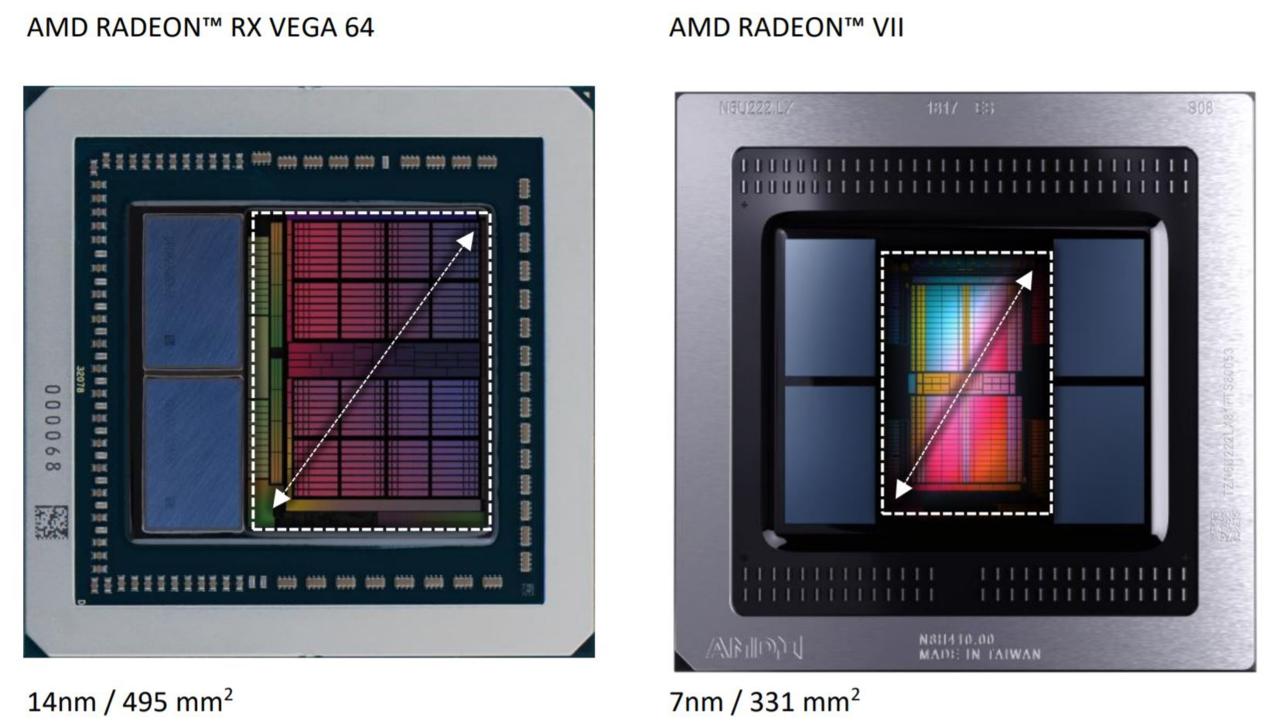
When using RX Vega 64 as a comparison, Radeon VII looks a lot more efficient by offering better clock speeds and memory configuration with a smaller die. But its 300-watt TDP indicates that we're still working with a power-hungry card, especially considering the RTX 2080's 215-watt TDP (225-watt for Founders Edition).
Specs and Methodology
For the purposes of testing the new AMD Radeon VII card, we used a high-end test bench equipped with the following specs:
- CPU: Intel Core i7-8700K CPU (6-core/12-thread, 3.7 GHz)
- Motherboard: ASUS ROG Maximus X Hero
- CPU Cooler: NZXT Kraken X62 liquid CPU cooler
- Memory: 16GB (8GBx2) HyperX Fury DDR4-2400MHz dual-channel RAM
- Storage: 1TB Samsung 970 EVO m.2 NVMe SSD
- PSU: EVGA SuperNOVA 850-watt 80+ Gold PSU
- OS: Windows 10 64-bit Home Edition
To paint a clearer picture of where the Radeon VII stands against other high-end options, we tested five video cards in total for this this review:
- Nvidia GeForce RTX 2080 Ti (Founders Edition)
- Nvidia GeForce RTX 2080 (Founders Edition)
- Nvidia GeForce GTX 1080 Ti (Founders Edition)
- AMD Radeon VII (Reference Card)
- AMD RX Vega 64 (Reference Card)
Note: At the time of testing, we used the latest GeForce driver version 418.81 for Nvidia cards and the pre-release Radeon Software version 18.50.15.02 for AMD cards.
The RTX 2080 was included since it's the most direct competitor (and in the same price tier as the Radeon VII), and we brought in the GTX 2080 Ti to see how wide the gap is between AMD's new top-end GPU and Nvidia's best consumer-level card. Also included is nvidia's previous generation powerhouse in the GTX 1080 Ti that still stands strong. And of course AMD's previous flagship card, RX Vega 64, was tested alongside Radeon VII to see just how much of a generational bump the new card has to offer.
For measuring performance, we chose eight games featuring comprehensive in-game benchmark tools that are representative of the more graphically demanding side of PC gaming. Since we're working with high-end video cards, resolutions of 4K and 1440p were tested while using the highest quality settings available in each game. The results can be seen below.
Benchmark Results
Assassin's Creed Odyssey
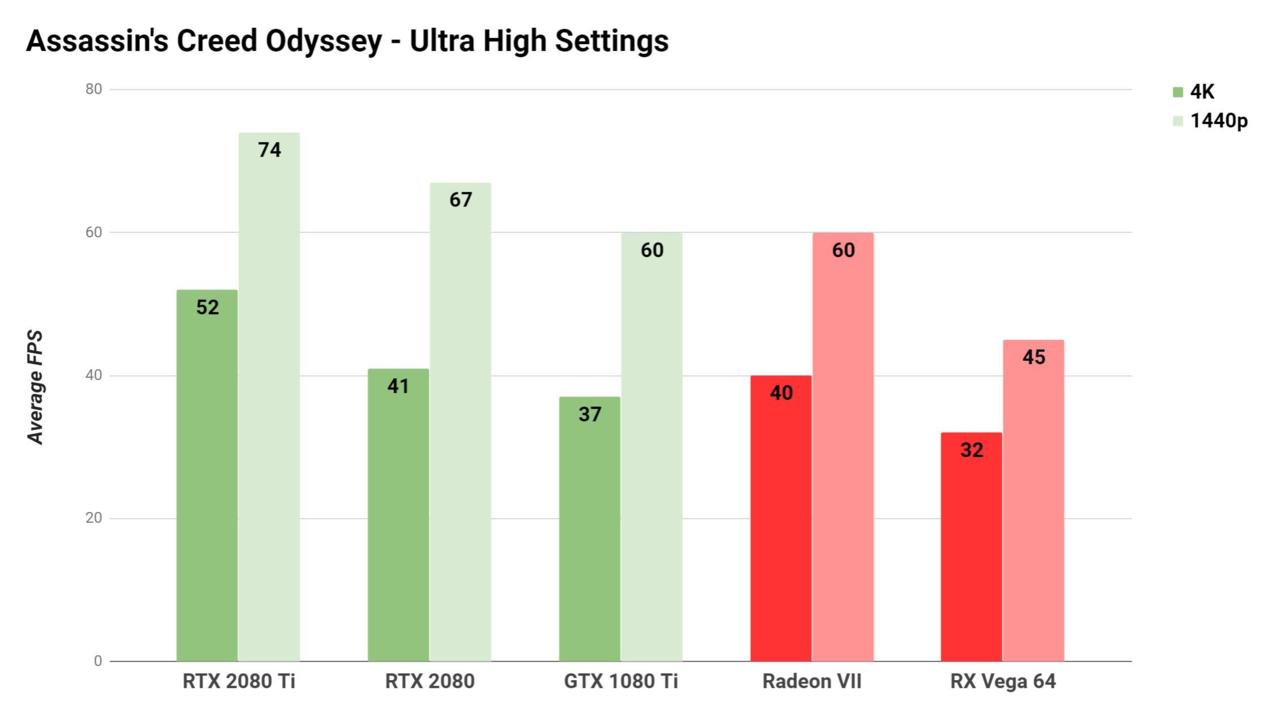
Ubisoft knows how to make a beautiful open world using the latest advanced graphics options that push your hardware, evident with Assassin's Creed Odyssey. To get our results, we used the built-in benchmark test that does a fly-by of the expansive landscape of Ancient Greece. We also used the "Ultra High" graphics preset which includes maxed out character detail, volumetric clouds, environmental quality, temporal anti-aliasing (TAA), and so much more.
At 4K, the Radeon VII performs nearly identically to the RTX 2080 with both cards getting an average of 40 FPS and 41 FPS, respectively. However, AMD's new card trails behind at 1440p with the RTX 2080 managing a seven-frame (or 11.7%) advantage. This also means the Radeon VII performs on par with the GTX 1080 Ti at 1440p, though it does offer a slight bump in 4K. Compared to the RX Vega 64, the Radeon VII offers a 25% and 33.3% performance boost in 4K and 1440p, respectively.
Shadow of the Tomb Raider
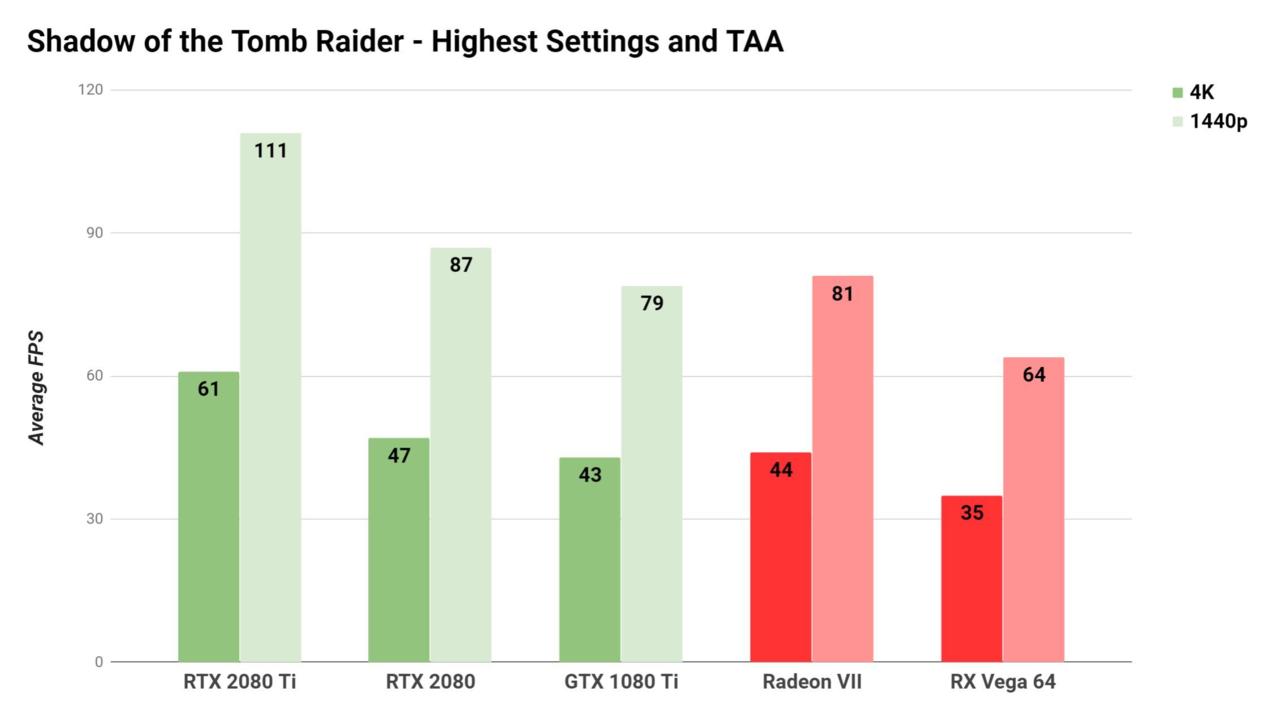
Shadow of the Tomb Raider is another visual showcase with robust graphics options and a built-in benchmark tool that takes you through vast, detailed environments. Using the "Highest" graphics preset, we have visual effects like volumetric lighting, HBAO+, tessellation, and great-looking shadows along with TAA to help clean up image quality.
The Radeon VII gets averages of 44 FPS in 4K and 81 FPS in 1440p; this comes close to matching the RTX 2080 in average FPS, as Nvidia's card leads by a handful of frames (6% in 4K and 7% in 1440p). This also means that the Radeon VII beats out the GTX 1080 Ti by just a hair, and outperforms Vega 64 by 25.7% in 4K and 26.6% in 1440p.
Forza Horizon 4
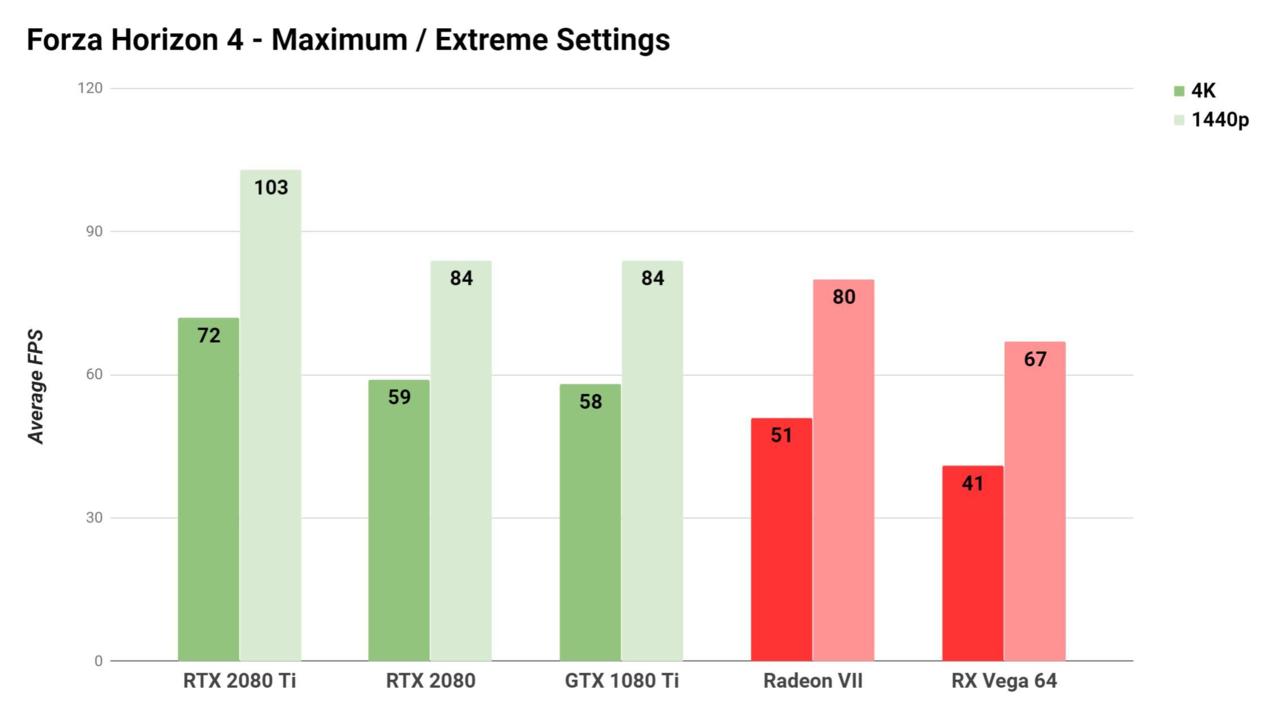
The Forza Horizon series has always had beautiful landscapes in open worlds for you to whip around and race your custom-tuned cars. Horizon 4 is the best example of that, and thankfully it comes with an in-game benchmark that takes you through a full race with crowds, weather effects, and scenic views.
The Radeon VII has some trouble keeping up in 4K as the RTX 2080 overtakes it by 15.7% and GTX 1080 Ti by 13.7%. The gap closes in 1440p since both aforementioned Nvidia cards only lead by 5% each. But between AMD generations, the Radeon VII zooms past the RX Vega 64 by 24.4% in 4K and 19.4% in 1440p.
Final Fantasy XV
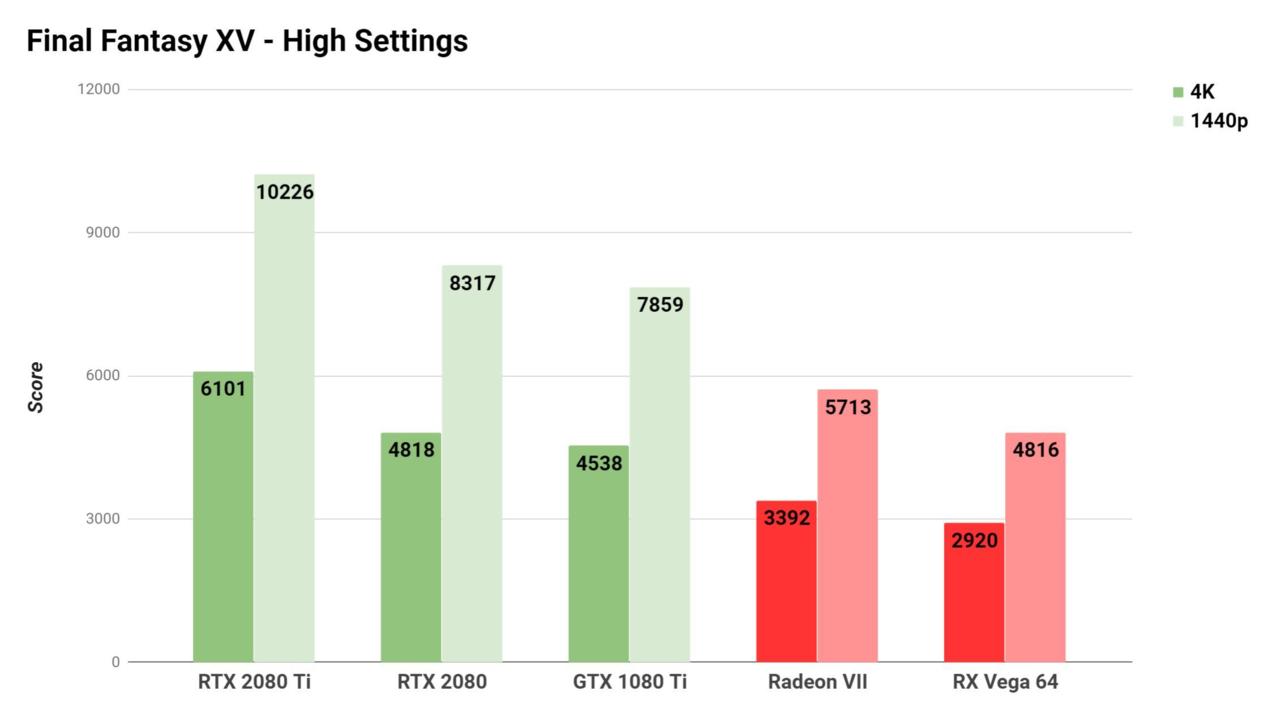
Square Enix offers the Final Fantasy XV benchmark tool for free, so those who don't have the game can still see how well their system performs in one of the best-looking RPGs to date. The test itself is lengthy and takes you across Eos in the Regalia, through a few battles, and to a campsite where Ignis cooks up a tasty dish. However, the test itself doesn't give you FPS results or a performance breakdown and instead spits out a total score. A general rule of thumb for this test is to divide the score by 100 to get a rough estimate of the average FPS.
AMD cards don't do particularly well in Final Fantasy XV, evident in the fact that the Radeon VII lags behind the RTX 2080 by 42% at 4K and 45.6% at 1440p. It doesn't come all that close to the GTX 1080 Ti either. Radeon VII does offer a 16.2% and 18.6% bump over the Vega 64 at 4K and 1440p, respectively.
Middle-earth: Shadow of War
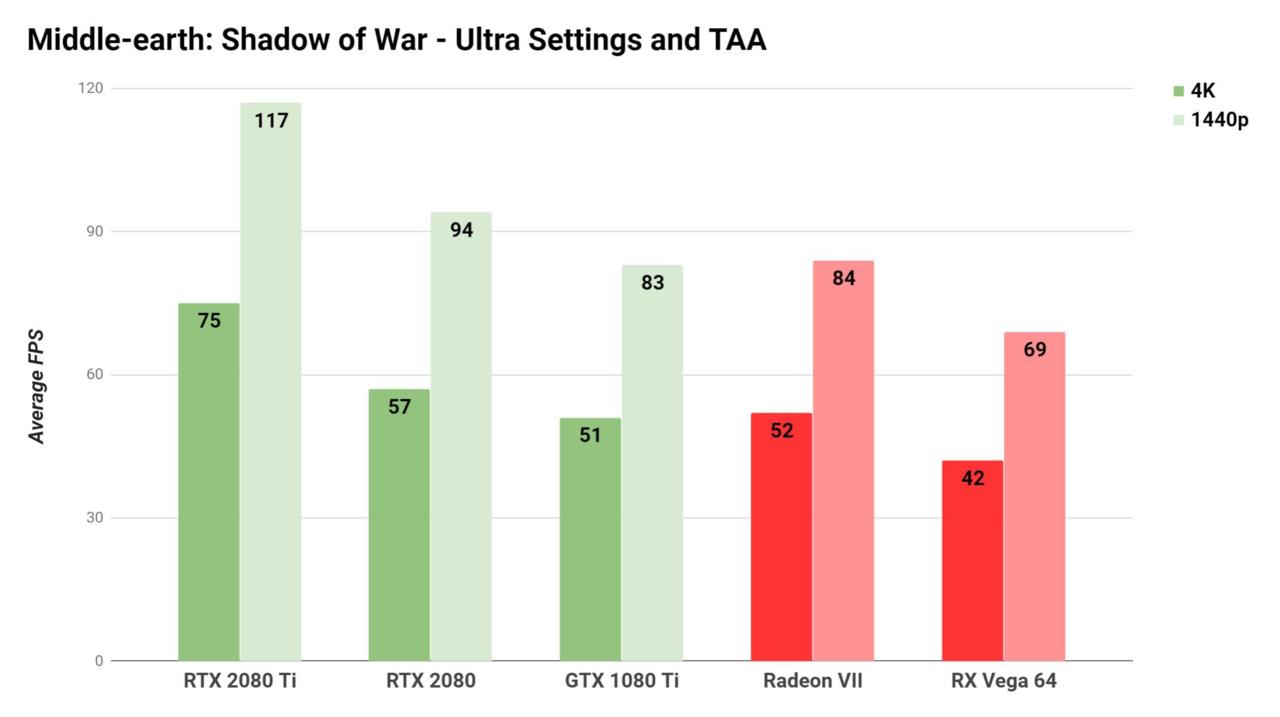
2017's Middle-earth: Shadow of War offers a variety of graphics options that let you crank up things like ambient occlusion and tessellation; the game also comes with a good benchmark tool that showcases several effects and large crowds in a short camera fly-by. We used the Ultra quality preset and TAA for antialiasing.
Here, the Radeon VII edges out the GTX 1080 Ti ever-so-slightly by one FPS in both resolutions, but gets beaten by the RTX 2080 by 9.6% in 4K and 11.9% in 1440p. As for improvement over last generation, the Radeon VII offers a boost of 23.8% in 4K and 21.7% in 1440p.
Deus Ex: Mankind Divided
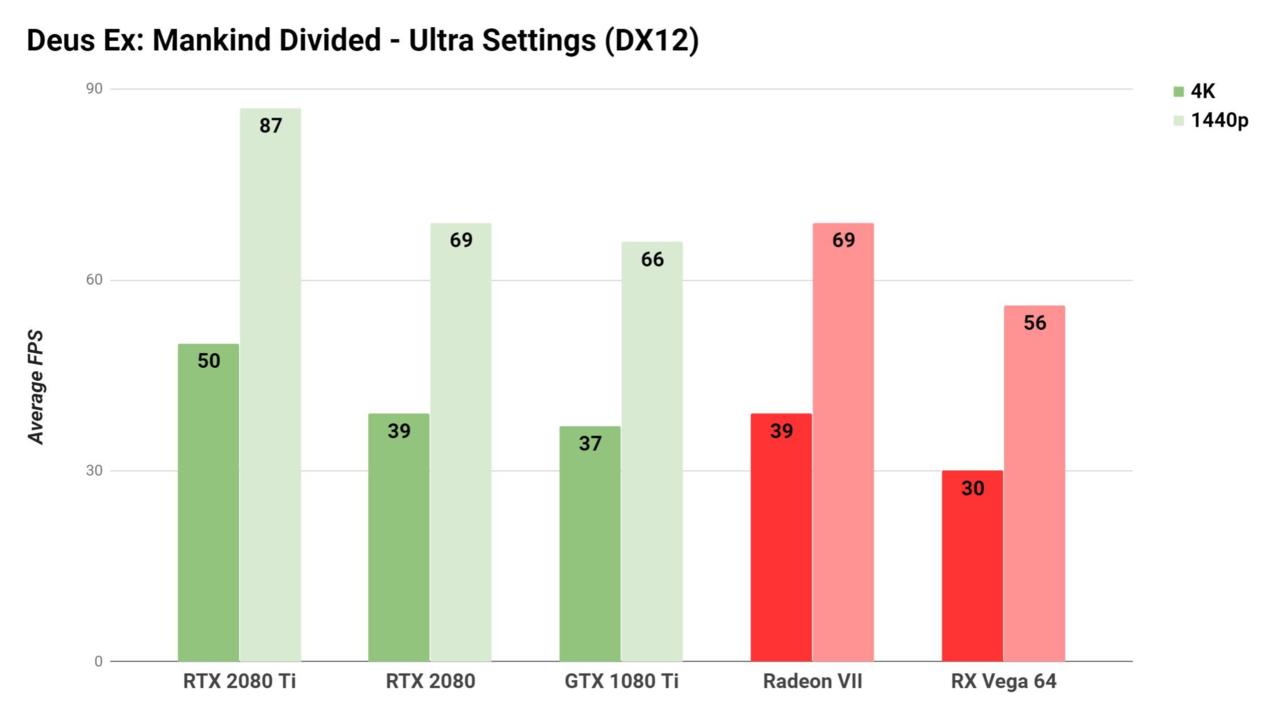
Deus Ex: Mankind Divided is a resource-heavy game with all its eye candy cranked up. It offers a ton of options like tessellation, high-quality ambient occlusion, cloth physics, contact hardening shadows and a whole lot more. The in-game benchmark sequence takes you through a marketplace in Golem City where character models, lighting, and shadows come into play, and it gave us our results here.
This is one game where the Radeon VII performs identically to the RTX 2080 in both 4K and 1440p, which means it gets a slight lead on the GTX 1080 Ti by just a few FPS. Compared to its predecessor, the Radeon VII shows a 30% and 23.2% improvement in 4K and 1440p, respectively.
Grand Theft Auto V
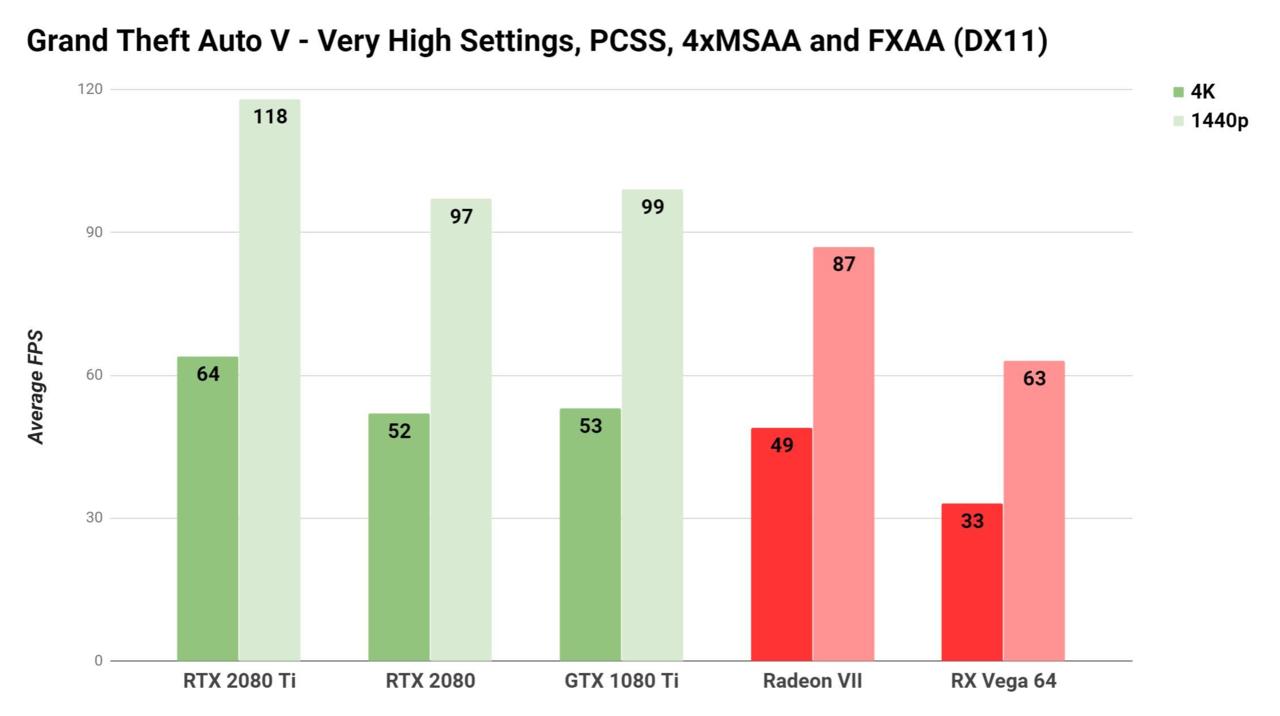
Grand Theft Auto V doesn't have any presets in the graphics options, so we tinkered with the settings ourselves. We set everything to Very High, used PCSS soft shadows, applied 4x MSAA along with FXAA. Despite being an older game, GTA V can still push high-end systems when running 4K resolution. The in-game benchmark tool runs five different sequences, each with their own average FPS, so took the average of all those sequences for the final result.
At 4K, the Radeon VII almost keeps up with the RTX 2080 and GTX 1080 Ti, only trailing by a few FPS. However, the gap slightly widens at 1440p with the AMD card behind the 1080 Ti by 11.2% and 2080 by 9%. Radeon VII does make a significant jump of 48.5% at 4K and 38.1% at 1440p compared to last gen's Vega 64.
Metro: Last Light
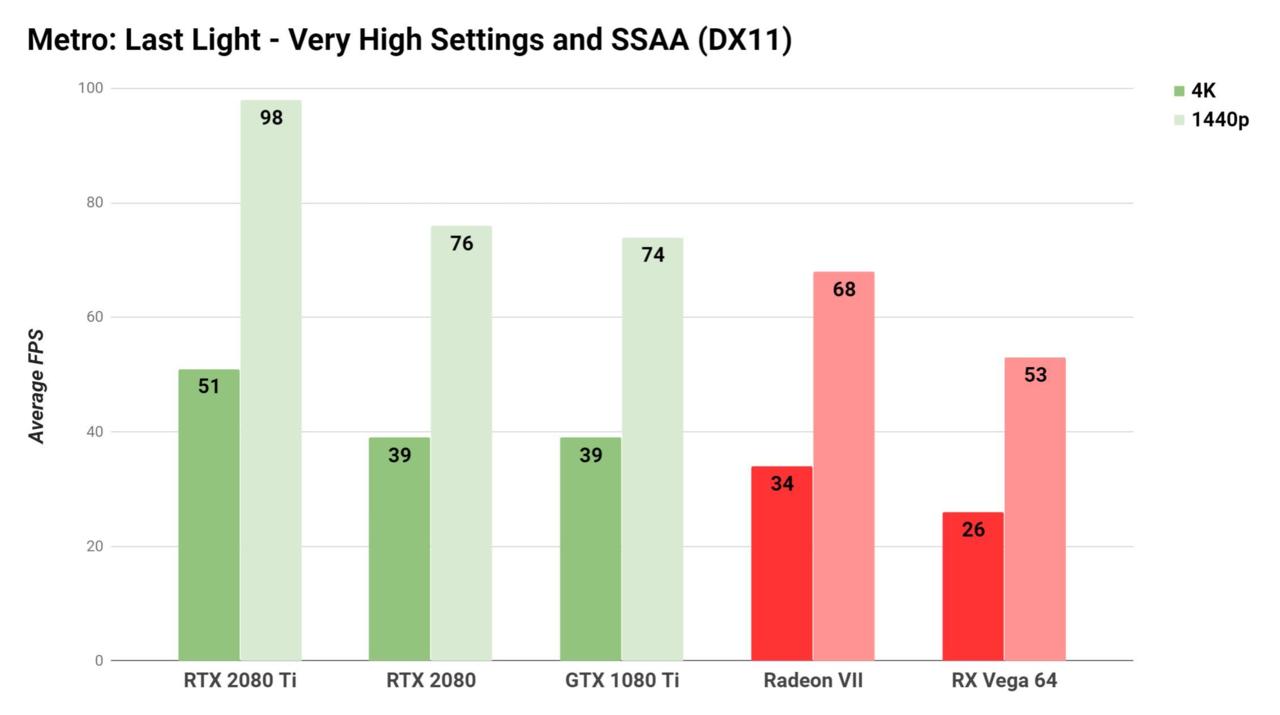
While Metro: Last Light is the oldest game of the bunch, it can still stress powerful PCs when you throw supersampling into the mix at high resolutions. The game's benchmark tool takes you through a slow motion fly-by of the game's final fight sequence that has special effects and many character models all at once.
The Radeon VII trails both the RTX 2080 and GTX 1080 Ti by 14.7% at 4K but closes the gap slightly in 1440p just behind the 1080 Ti by 8.8% and the 2080 by 11.8%. When put against the Vega 64, the Radeon VII pulls ahead by 30.8% at 4K and 28.3% at 1440p.
Temperatures
Of all five cards in our review, the Radeon VII unfortunately takes the cake when it comes to load temperature. When accounting for Radeon VII's high TDP, it would be expected for it to run hot, but with a whopping peak load temperature of 104 C, it surpasses every other card by a longshot. Thankfully, this didn't result in any functional issues, but those who want to run a cool system should take note. Radeon VII's cooling solution may not the best for keeping temperatures down, but its fans stay fairly quiet.
| Video Card | Idle Temp (Celsius) | Load Temp (Celsius) |
|---|---|---|
| Nvidia RTX 2080 Ti | 31 C | 78 C |
| Nvidia RTX 2080 | 30 C | 75 C |
| Nvidia GTX 1080 Ti | 36 C | 85 C |
| AMD Radeon VII | 34 C | 104 C |
| AMD RX Vega 64 | 37 C | 84 C |
Load temperature measurements were obtained via CPUID HWMonitor when performing the Assassin's Creed Odyssey benchmark.
Verdict
The scope of our tests intended to cover how the card handles graphically demanding games relative to AMD's previous generation and the competition. It's fair to say that the Radeon VII isn't a slouch, as it puts up in-game performance numbers close to the RTX 2080.
Those who want to stay within the AMD ecosystem should be happy to know that the Radeon VII can handle games in 4K at high settings with playable framerates, which shows significant improvement over RX Vega 64. If you have your eyes set on 4K display or high refresh rate 1440p FreeSync monitor, Radeon VII is of course the best option from AMD. Also keep in mind that future AMD drivers may help with optimizations or improved performance, but that's something we have to see develop software matures.
However, the bummer is that at the Radeon VII costs $700, the same as the RTX 2080. So, it's tough to make a compelling case for Radeon VII given the performance metrics, efficiency, and price point of your other option. You can't help but wonder why one would choose to go with AMD's current offering when Nvidia is paving the way for new tech like real-time ray tracing and DLSS, both of which look like promising features as more games adopt them. In addition, support for Nvidia hardware using adaptive sync (or FreeSync) continues to grow, further sweetening the deal for those strictly looking for the best value in a GPU for PC gaming.
If anything, Radeon VII gives AMD an avenue to challenge Nvidia in the high-end graphics card space, and it's a necessary competitor, especially if AMD decides to be more flexible and offer aggressive pricing in the future.










